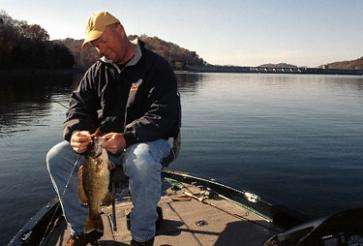
I’ve spent the last three blogs talking about night fishing, but I know that night fishing is not for everyone. I love it, but a couple of friends of mine, Jonathan Sanders and James Thomas, recently took me to school in the bright light of day with a technique that really opened my eyes.
Now Jonathan and James are a little older than I am, and they have a lot of experience chasing smallmouths on Dale Hollow and all over the country. When they come into my store to buy baits, I pay special attention to what goes into their sacks because I know it must be working.
So when they recently picked up a few Super Spooks and Wounded Zara Spooks in the heat of summer, I wanted to know what they were up to.
Well, these fellows are the salt of the earth and are always happy to share their successful methods with anyone who asks, but I have to admit to being a little skeptical when they said they were catching big brown bass on topwaters during the bright, sunny part of the day. I wanted to see them in action.
So they said, “Come on, let’s go!” And since no one’s ever had to ask me twice to go fishing, we were off.
After a short boat ride to a flat that has produced several nice smallmouths for me over the years, they reached into their rod lockers and pulled out four baitcasters with topwater baits on them. Two were rigged with Wounded Zara Spooks that had been modified by taking off the front propeller, and two were rigged with shad-patterned Super Spooks.
Since the sun had been up for some time by now, I wasn’t expecting much out of them.
They started with the Wounded Spooks, casting from deep water up onto the shallow flat that offered some grass cover and started working those baits hard — really ripping them for all they were worth.
Now, when you take that front prop off a Wounded Spook, it doesn’t really stay on top of the water very much. Instead it sputters a little before diving just under the surface. What’s more, it sounds just like feeding bass — at least to me.
They were ripping these baits along and tearing up the surface when all of a sudden Jonathan gets a strike on the Wounded Spook. He set the hook, but missed the fish, and they both started cranking those lures back to the boat as fast as they could.
When they got them in, they dropped those rods and picked up the rods with the Super Spooks. They made casts back to where that first bass hit and started walking the dog with the stickbaits.
Wham! Wham! Before I knew it, they had a double! I couldn’t believe it!
Unfortunately, both of those smallmouths — good ones, too — got off. So they cranked in again and made another cast each.
Wham! Wham!
Another double! But this time they got them both in the boat — solid 3- and 4-pounders.
I was impressed … and convinced! This technique works.
Talking with them about it a little more, I learned that this 1-2 punch is dynamite on feeding flats and main lake points — anywhere you’ve got good concentrations of baitfish.
At first, I found it hard to believe that they got most of their bites between 9 and 11 in the morning, long after the sun is on the water. Then they explained to me that another of their keys to success is wind to break up the surface and help draw the fish up. Before 9 or so, there’s just not much wind on the water, and that’s a critical element.
So, if night fishing just isn’t your thing, don’t worry. There are plenty of other ways to catch big brown fish all summer long … as long as you keep an open mind and are willing to try different things and learn from other anglers.
That’s what I do!
Until next time, if you have any questions or comments, I’d love to hear from you. Please e-mail me atStephen@thesmallmouthguru.com.





